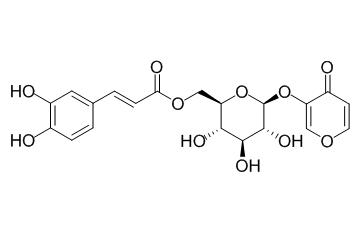Erigeside I is a radical scavenger.
Providing storage is as stated on the product vial and the vial is kept tightly sealed, the product can be stored for up to
24 months(2-8C).
Wherever possible, you should prepare and use solutions on the same day. However, if you need to make up stock solutions in advance, we recommend that you store the solution as aliquots in tightly sealed vials at -20C. Generally, these will be useable for up to two weeks. Before use, and prior to opening the vial we recommend that you allow your product to equilibrate to room temperature for at least 1 hour.
Need more advice on solubility, usage and handling? Please email to: service@chemfaces.com
The packaging of the product may have turned upside down during transportation, resulting in the natural compounds adhering to the neck or cap of the vial. take the vial out of its packaging and gently shake to let the compounds fall to the bottom of the vial. for liquid products, centrifuge at 200-500 RPM to gather the liquid at the bottom of the vial. try to avoid loss or contamination during handling.
Free Radic Res. 2012 Mar;46(3):286-94.
Screening of free radical scavengers from Erigeron breviscapus using on-line HPLC-ABTS/DPPH based assay and mass spectrometer detection.[Pubmed:
22239535 ]
Erigeron breviscapus is a well-known traditional Chinese herbal medicine.
METHODS AND RESULTS:
In this study, on-line HPLC-ABTS/DPPH assay coupled with MS detection were applied to screen and identify the free radical scavengers in 70% methanol extracts of E. breviscapus. Using on-line HPLC-ABTS-MS and HPLC-DPPH-MS assay, 13 radical scavengers (including 4-O-caffeoylquinic acid (4-CQA) (1), 9-caffeoyl-2,7-anhydro-2-octulosonic acid (9-COA) (2), 3-caffeoyl-2,7-anhydro-3-deoxy-2-octulopyranosonic acid (3-CDOA) (3), Erigeside I (4), quercetin-3-O-glucuronide (5), eriodictyol-7-O-glucuronide (6), scutellarin (7), 1,4-di-O-caffeoylquinic acid (1,4-di-CQA) (8), 3,5-di-CQA (9), 1-malonyl-3,5-di-CQA (10), erigoster B (11), 4,5-di-CQA (12) and 4,9-di-CDOA (13)) and 9 radical scavengers (including 1, 4, 7, 8, 9, 10, 11, 12 and 13) were discovered, respectively. Furthermore, the anti-oxidative activities of 4 compounds, including 7, 9, 11 and 12 were evaluated. Reverse anti-oxidative activity order of scutellarin and 3,5-di-CQA was observed in on-line HPLC-ABTS assay and on-line HPLC-DPPH assay. To validate their anti-oxidative activities, the off-line ABTS and DPPH assays were performed. Given sufficient reaction time, 3,5-di-CQA showed higher activity than scutellarin, which was consistent with the order obtained in on-line HPLC-ABTS assay.
CONCLUSIONS:
These results revealed that on-line HPLC-ABTS assay is a more sensitive method for screening and determining free radical scavengers, especially more suitable for those compounds with slower reaction kinetics.



